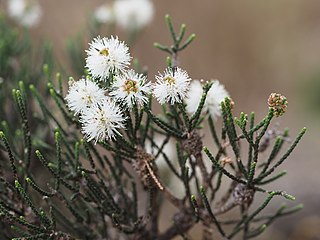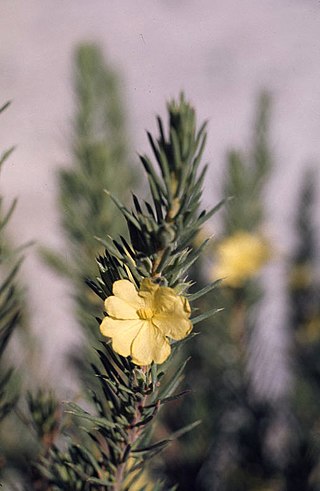
Melaleuca thyoides, commonly known as salt lake honey-myrtle is a plant in the myrtle family, Myrtaceae and is endemic to the south-west of Western Australia. It is an erect shrub with grey, papery or fibrous bark and very small, overlapping leaves on thin branchlets. It is a salt tolerant species often found on the edges of salt lakes.
Verticordia densiflora var. cespitosa is a flowering plant in the myrtle family, Myrtaceae and is endemic to the south-west of Western Australia. It is a shrub with small leaves and pink, or pink and white flowers. It is one of five varieties of the species Verticordia densiflora.

Leptospermum incanum is a species of compact shrub that is endemic to Western Australia. It has hairy young stems, elongated egg-shaped leaves on a short petiole, relatively large white or pink flowers and fruit that fall from the plant when mature.

Leptospermum nitens is a species of slender shrub that is endemic to Western Australia. It has thin, fibrous bark, narrow egg-shaped to wedge-shaped leaves, white or pink flowers on short side branches and fruit with the sepals attached but that falls from the plant shortly after the seeds reach maturity.
Thryptomene costata is a species of flowering plant in the family Myrtaceae and is endemic to Western Australia. It is an erect shrub with upward pointing, egg-shaped leaves with the narrower end towards the base, and white or pink flowers with five petals and ten stamens.
Thryptomene caduca is a species of flowering plant in the family Myrtaceae and is endemic to a small area in the north-west of Western Australia. It is a spreading shrub with crowded egg-shaped leaves with the narrower end towards the base, and pink flowers with five petals and seven to nine stamens.
Thryptomene decussata is a species of flowering plant in the family Myrtaceae and is endemic to Western Australia. It is an erect shrub with upward pointing, egg-shaped leaves, and white or pink flowers with five petals and twenty to thirty stamens in two whorls.
Thryptomene duplicata is a species of flowering plant in the family Myrtaceae and is endemic to Western Australia. It is a spreading shrub with upward pointing, egg-shaped leaves with the narrower end towards the base, and white flowers with five petals and about fifteen stamens in two whorls.
Thryptomene eremaea is a species of flowering plant in the family Myrtaceae and is endemic to Western Australia. It is an erect shrub with upward-pointing, oval leaves and white or pale pink flowers with five petals and ten irregularly arranged stamens.
Thryptomene globifera is a species of flowering plant in the family Myrtaceae and is endemic to western areas of Western Australia. It is a shrub with crowded, upward-pointing, broadly egg-shaped leaves with the narrower end towards the base, and pale pink or mauve flowers with ten stamens.
Thryptomene hubbardii is a species of flowering plant in the family Myrtaceae and is endemic to a small area in the west of Western Australia. It is a spreading shrub with crowded broadly egg-shaped leaves with the narrower end towards the base, and flowers with five pale pink petals and nine or ten stamens.
Thryptomene johnsonii is a species of flowering plant in the family Myrtaceae and is endemic to a restricted area of Western Australia. It is a bushy shrub with rigid branches, egg-shaped leaves with the narrower end towards the base and pink flowers with five petals and usually eight stamens.
Thryptomene naviculata is a species of flowering plant in the family Myrtaceae and is endemic to central areas of Western Australia. It is a rounded shrub with overlapping, decussate, egg-shaped leaves with the narrower end towards the base and white flowers with five petals and five stamens.
Thryptomene nitida is a species of flowering plant in the family Myrtaceae and is endemic to a small area in the south-west of Western Australia. It is a spreading shrub with upward-pointing, egg-shaped leaves with the narrower end towards the base, and flowers with five pale purple or pinkish petals and ten stamens.
Thryptomene orbiculata is a species of flowering plant in the family Myrtaceae and is endemic to the west of Western Australia. It is a shrub with broadly egg-shaped to more or less round leaves, and flowers with five pinkish petals and usually ten stamens.
Thryptomene podantha is a species of flowering plant in the family Myrtaceae and is endemic to the west of Western Australia. It is a shrub with egg-shaped leaves with the narrower end towards the base, and flowers with pink sepals and petals and ten stamens.
Thryptomene repens is a species of flowering plant in the family Myrtaceae and is endemic to a restricted area in the west of Western Australia. It is a prostrate shrub with egg-shaped leaves with the narrower end towards the base, and flowers with pink sepals and petals and ten stamens.
Pultenaea adunca is a species of flowering plant in the family Fabaceae and is endemic to the south of Western Australia. It is an erect, spindly shrub with hairy, needle-shaped leaves and yellow and red flowers.
Hibbertia helianthemoides is a species of flowering plant in the family Dilleniaceae and is endemic to a small area in the south-west of Western Australia. It is a prostrate to low-lying, spreading to erect, hairy shrub with hairy foliage, linear leaves and yellow flowers with thirteen stamens.

Hibbertia mucronata is a species of flowering plant in the family Dilleniaceae and is endemic to the south of Western Australia. It is an erect shrub with hairy branches, crowded, thick, tapering linear leaves ending in a sharp point, and golden yellow flowers with five stamens fused at their bases, all on one side of two densely hairy carpels.




